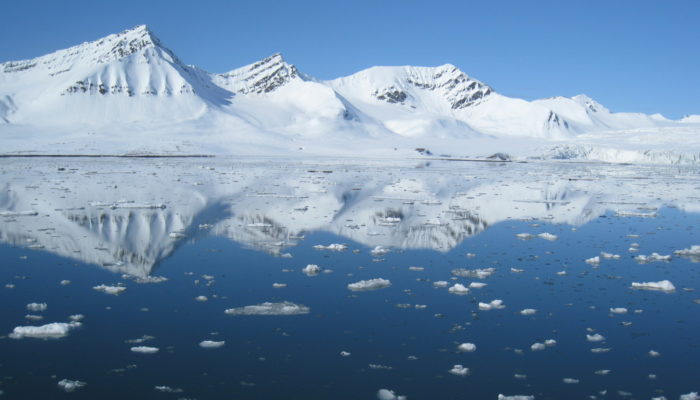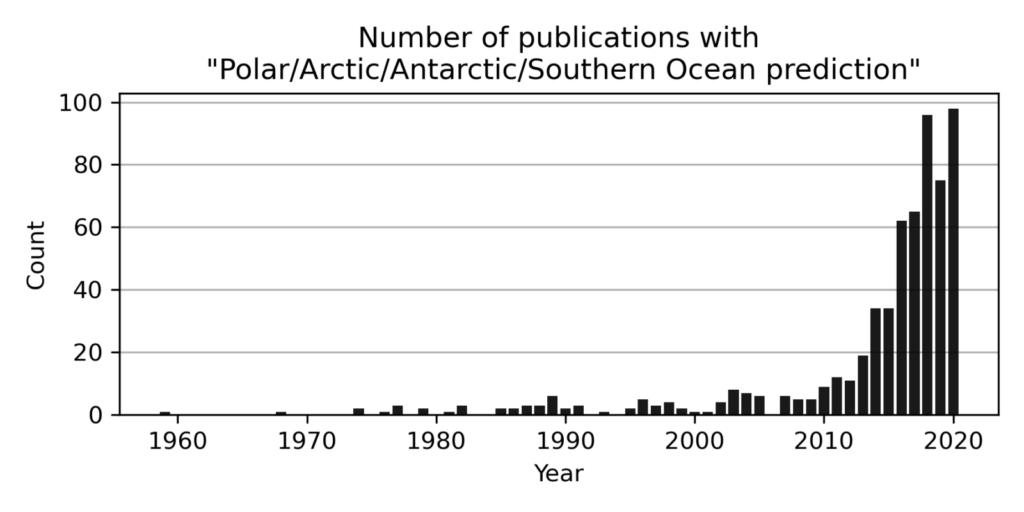
More than 11 years ago, I joined the Université catholique de Louvain (UCLouvain) in Belgium as a teaching assistant. The 2007-2009 International Polar Year (IPY), a worldwide collaborative effort aiming at better understanding our polar regions, had just finished, and the scientific community was concerned about the sudden drop in the summer Arctic sea ice extent that had occurred two years before (2007). This event had literally taken everyone by surprise! The same year, the Fourth Assessment Report (AR4) of the United Nations Intergovernmental Panel on Climate Change (IPCC) had projected that the Arctic could be free of sea ice during the summer months by the mid-21st century if we followed the business-as-usual scenario. The concerns were amplified as climate model projections appeared to collectively report conservative results which were unmatched to the observations (Stroeve et al., 2007).
When I defended my Ph.D. thesis in 2014 at the Université catholique de Louvain, two contrasting events had occurred in polar regions. In September 2012, the Arctic sea ice extent dropped by a stunning 40% relative to the 1981-2010 average, shattering the 2007 record. From workshop discussions (yes, we were traveling those days…), I vividly remember a heated discussion with colleagues. The main question on everyone’s mind was: ‘has the Arctic entered a runaway spiral of death?’ Two years later, in September 2014, the Antarctic sea ice extent settled a record high, exceeding the 1981-2010 average by 8%. How was such a high record possible, given that the Earth’s global temperatures were continuing to rise, and that ice would be expected to melt in a warmer world? And how confident could we be about Antarctic sea ice projections, given that nearly all models simulated a decline, not an increase, in sea ice extent, since the beginning of the satellite era?
Rapid progress in polar prediction
The chain of events that occurred in a couple of years triggered an enthusiastic interest from the research community to develop the knowledge, the skills, and the tools to enhance predictive capacity from hourly to multi-decadal time scales in polar regions. According to statistics obtained from the website dimensions.ai, an Artificial Intelligence platform that performs statistics on publications, the number of scientific contributions on the theme of polar prediction or similar has increased exponentially in recent years (Fig. 1).
I believe that four game-changers lead to this rapid progress:
- First, fundamental breakthroughs have been made in understanding the mechanisms of polar predictability at sub-seasonal to multi-decadal time scales. A good overview can be found, for example, in Shepherd (2011). Progress in our understanding of the mechanisms governing sea ice predictability has been particularly remarkable (Chevallier et al., 2019; Guemas et al., 2014) in such a short amount of time.
- Second, climate models and their sub-components (ocean, atmosphere, sea ice, and land models) have become more sophisticated thanks to increasing spatial resolution, the inclusion of more physical processes, and better use of observational data to develop, evaluate, calibrate, and initialize their predictions.
- In parallel, the advent of affordable supercomputing power has allowed running a very large (from 30 up to sometimes more than 100) “members”, or digital copies of the same model to sample the uncertainty associated with the (unpredictable) evolution of the atmosphere beyond weather time scales. This may sound counterintuitive, but we are today in a better capacity than 15 years ago to describe how uncertain our forecasts are, which is a great step forward for science.
- Finally, large-scale international programs like the Sea Ice Prediction Network (SIPN), the Polar Prediction Project (PPP), with its flagship activity the Year of Polar Prediction (YOPP), or the APPLICATE Horizon 2020 EU project, have been monumental in mobilizing scientists and governmental agencies to turn grand research challenges into concrete outcomes. I am biased here because I am quoting three programs in which I have been involved for quite some time, and there are of course so many more that should be highlighted. But the point is: polar prediction would never have been as successful as it is now, if research had not been made possible across the national and institutional boundaries.

Figure 1. Number of publications listed by dimensions.ai that include any of the following phrases: “Arctic prediction”, “Polar prediction”, “Southern Ocean prediction” or “Antarctic prediction”.
Next challenges
The next 10-20 years will come with their lots of exciting challenges, research questions and opportunities, which will orient polar prediction on many aspects:
- With the Arctic transitioning towards a seasonally covered sea ice state, weather and seasonal prediction will progressively become a new area of research of its own, as the mechanisms of weather and predictability will quite likely be affected by the new Arctic state. Predicting the Arctic climate is becoming like chasing a moving target! We are not even sure if our predictive models and the currently available polar observations are adapted to perform predictions in the coming decades.
- The emergence of approaches inspired from Artificial Intelligence (AI) brings a fresh and healthy wind of change on the way we envisage polar prediction. Recent results give encouraging signs, and I bet that by 2030, we will have seen a dramatic increase in the diversity of methods used to perform predictions. A clear challenge will be to combine and make sense of different lines of evidence (e.g., from dynamical climate models and AI-based models) in multi-model prediction studies based on different approaches.
- In the Antarctic, prediction on all time scales is notoriously more difficult due to a sparser data coverage compared to the Arctic, and due to the inability of most global climate models to represent fine-scale processes and interactions between ocean, ice sheets and ice shelves, sea ice, and the atmosphere. In the upcoming years, we will see the development of new targeted configurations linking those components together, delivering an unprecedented level of understanding about how these high-latitude processes work and how they operate across time- and space scales.
- A lot of work remains to be done to make our polar predictions not just skillful but also useful. The co-development of case studies (see for example here) that involve scientists, stakeholders, and indigenous communities will be key to transform abstract concepts like polar amplification or sea ice extent decline, into concrete narratives that explain what those changes imply in terms of weather shifts, and particular in the change of extremes.
I have had the chance to be part of this adventure from almost day one. With many other enthusiastic colleagues, I consider myself to be part of the ever-growing “generation #polarprediction” that makes a wide use of social media besides their everyday research work. Social media have profoundly reshaped the way we exchange knowledge and share science. They also frequently help me grasp the way complex physical phenomena work (do you wonder how near-surface Arctic air temperatures can sometimes climb above freezing point in the middle of winter?) but also to alert the public about rapid changes at high latitudes or the recent cold air outbreak in Europe last week.
The amount of (wo)manpower that has been put toward increasing our ability to predict polar weather and climate is just astonishing in hardly a couple of years. Personally, what I find the most exciting is that this seems to be only a beginning.
This post has been edited by the editorial board.
References Chevallier, M., Massonnet, F., Goessling, H., Guémas, V., & Jung, T. (2019). The Role of Sea Ice in Sub-seasonal Predictability. In Sub-Seasonal to Seasonal Prediction (pp. 201–221). Elsevier. https://doi.org/10.1016/B978-0-12-811714-9.00010-3 Guemas, V., Blanchard-Wrigglesworth, E., Chevallier, M., Day, J. J., Déqué, M., Doblas-Reyes, F. J., Fučkar, N. S., Germe, A., Hawkins, E., Keeley, S., Koenigk, T., Salas y Mélia, D., & Tietsche, S. (2014). A review on Arctic sea-ice predictability and prediction on seasonal to decadal time-scales. Quarterly Journal of the Royal Meteorological Society, 142(695), 546–561. https://doi.org/10.1002/qj.2401 Shepherd, T. G. (2011). Mechanisms for Predictability of Polar Climate. Eos, Transactions American Geophysical Union, 92(11), 92–92. https://doi.org/10.1029/2011EO110005 Stroeve, J., Holland, M. M., Meier, W., Scambos, T., & Serreze, M. (2007). Arctic sea ice decline: Faster than forecast. Geophysical Research Letters, 34(9). https://doi.org/10.1029/2007GL029703
